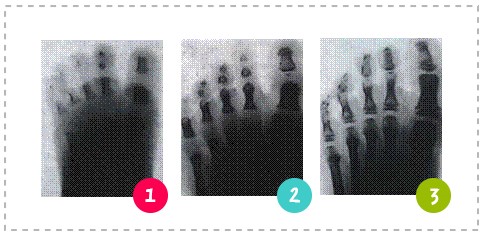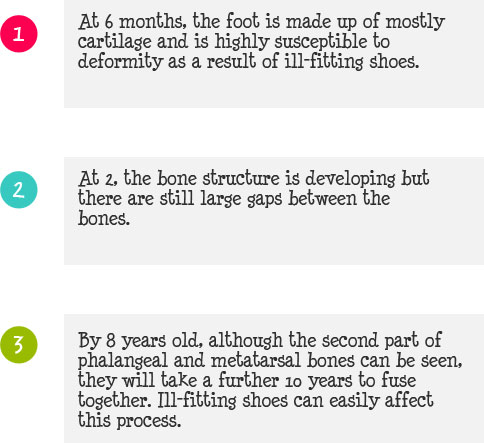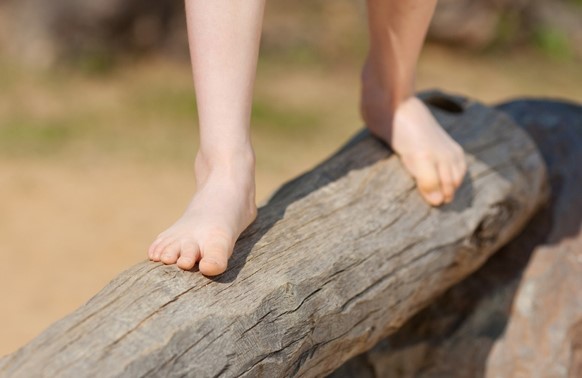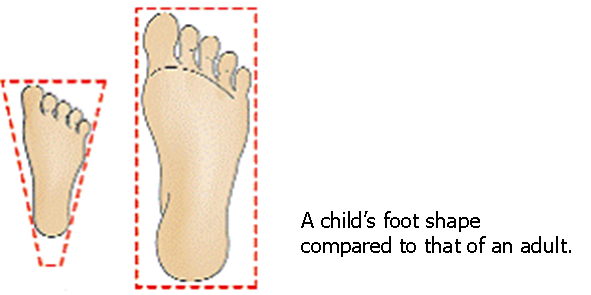You may check out all the available products and buy some in the shop.
Foot Health
Before you read on we recommend that you take 5 minutes to watch this excellent Shoespiracy video. It will challenge you to think differently about your shoes and the negative effects your footwear is having on your feet, the way you move and ultimately your health.
Why Go Barefoot?
The human foot is amazing and has adapted over many millions of years to suit the needs of walking and running long distances. The amazing combination of bone structure, muscles and nerve endings enable us to adopt a range of movements necessary for daily life. The foot has evolved to be perfectly well adapted to the business of walking and running and doesn't generally need the support or structure of shoes to be able to achieve either comfortably. In adults, however, many years of wearing structured and restrictive shoes can lead to weak and underdeveloped muscle structures which limit the potential of the foot to move naturally and often result in more support being required over the years.
Young children have no such problems, their muscles are as yet undeveloped and their complex foot bone structure doesn’t fully develop around 18 years old. If we want to maximise the potential of their feet we need to allow them to develop natural muscle strength by giving lots of freedom to move unrestricted and lots of space for their feet grow and develop their natural bone structure and shape without interference. Medical experts worldwide agree that barefoot walking is not only the best thing for healthy foot development but also for general health. So it is vital, especially in the first few years of walking, but ideally until 18 and beyond, that the child’s foot is not subjected to ill fitting, rigid or inappropriate shoes.
Foot Anatomy
There are 26 bones, 19 muscles, 107 ligaments plus an array of delicate blood vessels, nerves and tissue fibres all working together to control the movement of each foot. The majority of the brains information about movement comes from the nerve endings in the foot, making the feet and using the feet to sense the ground beneath very much part of balance and coordination. This is especially important in young children as they learn to walk.
Bones start out as cartilage and it isn’t until the child reaches about 18 years old that all of the constituent parts of the foot are fully developed. The arch also develops later in childhood, usually between ages 2 and 5 but sometimes later. It is not a structural part of the foot but a muscle that needs to be used and worked to develop. This is why toddler feet can appear very flat and can often seem to roll in or pronate.


All About Arches, Flat Feet and Pronation
We often get asked about arch supports by parents concerned about their children's feet being flat or seemingly rolling in. However we know that the majority of children between 1-5 years of age will have flat feet as their arch muscles have yet to develop. This is part of normal development of their feet and over 95 percent of children grow out of their flat feet and develop a normal arch. The other 5 percent will continue to have flat feet, but even of these only a small number will ever have a problem. The great majority of children under the age of five with a flat foot will develop a normal arch in their own time and don't need to use supportive shoes or insoles.
The arch is the bodies spring board, think of it like the spring board in a gym, it allows the muscles to super charge their movement and absorbs the shock of landing. Just think what would happen if you put a 'supportive' block under a spring board and tried to jump off it or land on it? It would probably cause quite a shock to the body as you landed and jar your skeletal structure and joints rather than allow your muscles to take the impact. The same happens when you put a support under the arch, the arch muscle is no longer able to act as that shock absorbing powerhouse with all the resulting impacts on your knees, hips and spine.
As with any muscle the arch needs to be used to develop and strengthen, this happens naturally through childhood play and lots of barefoot time or through using the most minimal shoes you can get away with. If there are concerns about persistent excessive pronation then foot exercises can be helpful and we highly recommend the two Katy Bowman books referenced below which contain lots of useful information along with a series of exercises to help strengthen the muscles. If you do have concerns then we always recommend consulting a health professional to rule out any underlying health conditions but be reassured that in the vast majority of cases this is a perfectly normal part of childhood development.
Barefoot is Best
The picture below shows a barefoot child, engrossed in her play, managing to balance perfectly well on a log. Here, by allowing her toes to perform their natural gripping action, her feet are naturally developing strength and coordination. Had she been wearing shoes, this natural development would have been compromised, meaning she would have had to adjust her bodily alignment to compensate, putting undue pressure on her spine and other major bone groups.

What Makes a Barefoot Shoe
Barefoot might be best but it’s not always practical and sometimes our children's precious feet need protection from rough surfaces, the wet and extremes of temperature. Fortunately barefoot shoes are springing up from brands across the globe. They are especially designed for our children to ensure their feet have the best possible start in life. When your child does need to wear shoes we recommend looking for a shoe that is as close to barefoot as possible.
So what makes a barefoot shoe? We have highlighted the main features to look for below:
Flexible
Flexible soles allow the foot and ankle to develop most naturally by enabling the foot to respond to changes in the walking environment and to make appropriate adaptations. They are recommended by podiatrists because they offer protection without being restrictive. When choosing a shoe, you should be at least able to bend the toe of the shoe up easily to help develop the immature muscles of the foot.
Zero drop and flat
The best soles are protective while simulating barefoot conditions and allowing feet to move and develop naturally without restriction or support. This means no heels, arch supports or other "molding" features. A barefoot shoe should completely flat from heel to toe with no heel rise or formal heel structure. This is referred to as being 'zero-drop'.
Thin Soled
A thin sole is essential to allow feet to be able to feel the texture of the ground through the shoes. This allows the 200,000 nerve endings in the foot to connect with the brain and provide important sensory feedback to the brain. This in turns helps balance and allows children to focus more on their surroundings. The more feet can feel, the more the foot-brain connection is stimulated and stays active. Thick, cushioned and supportive shoes cut off this all-important feeling, dulling the sensory feedback our brains can get from our feet.
Breathable
A foot has 250,000 sweat glands, with the potential to create a quarter of a pint of perspiration every day! Inners should be made of natural materials such as leather with uppers of leather or canvas rather than plastic. Breathable shoes will encourage good foot hygiene and prevent conditions such as athlete’s foot.
Lightweight
Shoes should not be heavy or impede the child’s movement in any way. Toddlers have enough of a hard time putting one bare foot in front of the other. The weight of a shoe, especially a heavy one, makes this task even more challenging. Heavy shoes can lead to a lack of confidence in agility, tired legs or worse with possible misalignment of the spine as children hold a different posture to overcompensate for the weight of the shoe they’re carrying.
Wide toe box
Children’s feet are not just a scaled down version of adult’s feet. They have a particular shape, rather like a triangle, and need shoes to reflect this. Good toddler shoes require a correspondingly much bigger toe area than the shape of an adult shoe. Many shoe manufacturers of children's shoes are simply scaled down versions of adult shoes. Wide toe boxes enable the child to wriggle their toes freely and importantly, allow their toes to spread without constriction as they grip the ground to walk. Not only should the toe box be wide, but the opening to the shoe should also be wide enough to enable the foot to slip in easily, without having to squeeze the toes in any way.

Durable
As shoes should only really be worn outside and in harsh environments, you need to make sure they will stand up to the elements. Durability is a challenge for a barefoot shoe trying to aim for the thinnest possible sole and it is worth noting that there is always a bit of a trade off between the thickness of the sole and durability, particularly in things like wellingtons which are made from softer natural rubber.
Non-slip
Soling material for outdoor shoes on hard surfaces such as playgrounds should be slip-resistant and hard wearing. Look for light rubber soles with grooves for traction or leather or suede soles with rubber padding in just the right places to provide greater durability.
Switching to Barefoot Shoes
We often get asked about transitioning to barefoot shoes and how to do it safely. For toddlers and young children this isn't an issue at all as their muscles and feet are still in the development phase, they haven't been affected as yet by conventional shoes and so will have no problems. Even younger children who have had periods in conventional shoes are usually fine and will adjust quickly as they will still have done the majority of their development barefoot. For older children who have spent significant time in structured shoes we recommend taking things slowly and carefully and wearing barefoot shoes for shorter periods at first, increasing gradually over a period of weeks.
Adults, however, who have spent many years of wearing structured and restrictive shoes need to take things very carefully and transition slowly, taking small steps in the right direction. Conventional shoes will have limited full movement in the joints of the foot which will in turn have often led to weak and underdeveloped muscle structures in the foot and lower leg. This in turn will have had impacts on the way you move and consequently on the pelvis and spine, particularly when it comes to regular high heel wearing. We recommend taking things very slowly, making small and steady adjustments to your footwear such as reducing the heel height, stopping wearing thicker soles and looking for wider toes boxes, switching to more minimal shoes over time. We also recommend undertaking an exercise programme to strengthen the foot and lower leg muscles in parallel to building up wearing more barefoot shoes. If you are interested in transitioning to barefoot shoes as an adult we thoroughly recommend reading Katy Bowman's excellent book 'Whole Body Barefoot' referenced below and which gives an excellent overview of this area along with a great series of exercises to help your transition.
Shoe and Foot Care
When you’ve chosen your child’s shoes, follow these great tips for keeping them and your child’s feet in tip top condition:
- Feet should be thoroughly washed and dried daily, especially between the toes.
- Toe nails should be kept short and straight.
- Footwear (including socks and babygros) should be made of natural fibres and not be too constrictive. Try not to tumble dry socks and tights as they tend to shrink.
- Socks and tights should have a heel and toe feature, not be just a long tube over the foot.
- Ideally, children should have more than one pair of shoes and alternate between them. Shoes should be changed 3-4 times a year. This prevents feet from becoming too ‘moulded’ to a particular shoe.
- Feet should be measured regularly, particularly in the first 3 years of walking.
- Shoes should be cleaned according to the manufacturers’ instructions.
- Shoes should be thoroughly aired after wearing them as sweat may cause dampness. However, do not rest shoes onto a direct heat source as this can warp the leather and cause the sole and upper to separate as leather and rubber dry at different rates.
Recommended Reading
We've listed below a few of the key books and articles that we have found most useful over the years and that we strongly recommend reading if you want more information. We have many more book recommendations, articles and information sources in our Resource section and do have a look at our Blog Page where we try to keep up to date with all the latest developments. These books below are however the ones we would start with and are essential reading for anyone wanting to find out more about foot health, the importance of natural movement and barefoot shoes:
- Katy Bowman (2015) Whole Body Barefoot, Propiometrics Press
- Katy Bowman (2016) Simple Steps to Foot Pain Relief, The New Science of Healthy Feet, BenBella Books Inc
 Free UK Returns
Free UK Returns